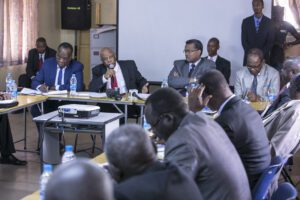Introduction
In Uganda’s rapidly evolving development landscape, the importance of robust monitoring and evaluation (M&E) systems cannot be overstated. As organizations strive to demonstrate impact and accountability, understanding and implementing effective M&E methodologies in Uganda has become a critical competency. Whether you’re a seasoned development professional or new to the field, mastering these approaches can significantly enhance your project outcomes and sustainability.
Uganda’s unique context—characterized by diverse regional challenges, evolving donor requirements, and ambitious national development goals—demands M&E systems that are both rigorous and adaptable. This comprehensive guide explores the most relevant M&E methodologies in Uganda, offering practical insights for development practitioners working across sectors.
Understanding the Fundamentals of M&E Methodologies in Uganda
Before delving into specific approaches, it’s essential to understand what sets M&E methodologies in Uganda apart from global practices. While the core principles remain consistent, Uganda’s development landscape has shaped unique applications and priorities.
The Ugandan Context
Uganda’s development sector operates within a framework defined by:
- The National Development Plan (NDP III)
- Sustainable Development Goals (SDGs) localization
- Donor harmonization initiatives
- Growing emphasis on locally-led development
- Increasing digital innovation
These factors collectively influence how M&E methodologies in Uganda are conceptualized and implemented. Organizations must balance standardized approaches with contextual adaptations that reflect local realities and priorities. For a deeper understanding of how these approaches are applied in practice, see QDIC’s comprehensive overview of M&E services in Uganda.
Monitoring vs. Evaluation: Clarifying the Distinction
A foundational understanding of M&E requires clear distinction between its two components:
Monitoring involves the continuous tracking of project activities, outputs, and initial outcomes. It answers the question, “Are we doing what we said we would do?” In the Ugandan context, this often means regular data collection on predefined indicators, activity tracking, and progress reporting.
Evaluation, by contrast, assesses the broader impacts and effectiveness of interventions. It addresses questions of relevance, effectiveness, efficiency, impact, and sustainability. In Uganda, evaluations increasingly emphasize learning and adaptation rather than just accountability.
Together, these components form a comprehensive approach to understanding and improving development interventions. Let’s explore the most prevalent M&E methodologies in Uganda and how they’re being applied across different sectors.
Major M&E Methodologies in Uganda
1. Logical Framework Approach (LFA)
The Logical Framework Approach remains one of the most widely used M&E methodologies in Uganda, particularly among international NGOs and government programs. This systematic planning tool helps articulate the causal logic of interventions through a structured matrix.
Key Components of LFA in Uganda:
- Goal/Impact: The broader development objective to which the project contributes
- Purpose/Outcome: The specific change the project aims to achieve
- Outputs: The direct deliverables produced by project activities
- Activities: The specific tasks undertaken to produce outputs
- Indicators: Measurable markers of progress at each level
- Verification Sources: Where and how data will be collected
- Assumptions: External factors that might affect success
Practical Application in Uganda:
The Ministry of Health in Uganda utilizes LFA for its primary healthcare programs, establishing clear linkages between community health worker activities, improved service delivery, and ultimate health outcomes. This structured approach has enabled consistent reporting across diverse regions and health facilities.
However, practitioners implementing M&E methodologies in Uganda have noted some limitations of LFA, including its sometimes rigid structure and challenges in capturing complex social change processes. This has led to adaptations and the integration of complementary approaches.
2. Theory of Change (ToC)
Theory of Change has gained significant traction among M&E methodologies in Uganda, offering a more flexible and comprehensive framework for understanding how change happens. Unlike the linear logic of LFA, ToC maps the complex pathways between actions and outcomes, acknowledging multiple causal routes and feedback loops.
Key Elements of ToC in Uganda:
- Long-term change: The ultimate impact sought
- Preconditions: What must be in place for change to occur
- Interventions: Activities designed to create needed preconditions
- Assumptions: Beliefs about how change happens and what influences it
- Indicators: Markers that show progress along the pathway
Practical Application in Uganda:
Educational initiatives in Northern Uganda have effectively employed ToC to address complex challenges in post-conflict settings. By mapping interconnected factors—including teacher training, community involvement, infrastructure, and student wellbeing—organizations have developed more holistic interventions and measurement frameworks.
The flexibility of ToC makes it particularly suitable for complex development challenges in Uganda, where multiple factors interact to influence outcomes. It allows organizations to articulate and test their underlying assumptions about change.
3. Results-Based Management (RBM)
Results-Based Management has become a cornerstone of M&E methodologies in Uganda, particularly in government-led initiatives and programs supported by major donors like UNDP and the World Bank. RBM shifts focus from activities and inputs to measurable results and outcomes.
Key Principles of RBM in Uganda:
- Results orientation throughout the management cycle
- Alignment of programming, monitoring, and reporting with intended outcomes
- Decision-making based on performance information
- Simple reporting focused on results
- Learning and adaptation based on performance information
Practical Application in Uganda:
Uganda’s agricultural extension services have adopted RBM to transform their approach from counting training sessions delivered to measuring actual changes in farming practices and productivity. This shift has enhanced effectiveness by focusing resources on interventions that demonstrate measurable impact on farmer livelihoods.
The emphasis on results rather than activities makes RBM particularly valuable in the Ugandan context, where limited resources must be allocated efficiently to achieve maximum impact.
4. Participatory M&E Approaches
Among the various M&E methodologies in Uganda, participatory approaches have gained particular prominence for their emphasis on inclusion and local ownership. These approaches actively involve stakeholders—especially project beneficiaries—in the design, implementation, and use of M&E systems.
Key Features of Participatory M&E in Uganda:
- Stakeholder involvement in identifying indicators and success criteria
- Local data collection and analysis processes
- Collective reflection and sense-making
- Shared decision-making about program adjustments
- Capacity building as an explicit goal
Practical Application in Uganda:
Community-based natural resource management initiatives around Uganda’s forest reserves have successfully implemented participatory M&E systems. These approaches have not only improved data quality by incorporating indigenous knowledge but have also strengthened community ownership and sustainability of conservation efforts.
Participatory methods address power imbalances common in traditional M&E methodologies in Uganda and help ensure that interventions remain relevant to local priorities and contexts.
5. Outcome Mapping
Outcome Mapping offers a distinctive approach among M&E methodologies in Uganda, focusing on behavioral changes in the key actors with whom a project works directly. It acknowledges that while projects contribute to development impacts, they cannot control all factors determining ultimate success.
Key Elements of Outcome Mapping:
- Boundary Partners: Individuals, groups, or organizations with whom the project interacts directly
- Outcome Challenges: Descriptions of how boundary partners’ behaviors would change if the project achieved optimal success
- Progress Markers: Graduated indicators of behavioral change
- Strategy Maps: Approaches used to influence boundary partners
Practical Application in Uganda:
Governance programs working to strengthen civil society in Uganda have adopted outcome mapping to track incremental changes in how local organizations advocate for community needs. This methodology has proven particularly effective for capturing subtle but important shifts in organizational behavior and capacity that traditional indicators might miss.
Outcome Mapping’s focus on contribution rather than attribution makes it well-suited to complex development challenges in Uganda where multiple factors influence ultimate outcomes.
Integrated Approaches: Combining M&E Methodologies in Uganda
In practice, most effective M&E systems in Uganda combine elements from multiple methodologies to create comprehensive frameworks tailored to specific contexts. This integration allows organizations to leverage the strengths of different approaches while mitigating their limitations.
Common Integrated Approaches:
LFA + ToC: Organizations often develop a detailed Theory of Change to inform a more streamlined logical framework, ensuring both comprehensive thinking and practical management tools.
Participatory Methods + RBM: Combining stakeholder involvement with results focus helps ensure that measured results reflect community priorities.
Outcome Mapping + Traditional Indicators: Supplementing standard output and outcome metrics with behavioral progress markers provides a more complete picture of project influence.
Many successful implementers of M&E methodologies in Uganda have moved beyond methodological purism to develop pragmatic, mixed approaches that serve both accountability and learning needs.
Selecting Appropriate Indicators for M&E in Uganda
The effectiveness of any M&E methodology in Uganda depends heavily on the quality of indicators selected. Well-crafted indicators should be:
- SMART (Specific, Measurable, Achievable, Relevant, Time-bound)
- Aligned with national and sectoral frameworks
- Balanced between quantitative and qualitative measures
- Sensitive to gender and inclusion considerations
- Feasible to collect within resource constraints
Indicator Selection Process:
- Review program objectives and theory of change
- Consult stakeholders, especially beneficiaries
- Examine existing indicator frameworks (SDGs, sector standards)
- Assess data collection feasibility and costs
- Prioritize indicators based on information needs and resources
- Develop detailed indicator reference sheets
In Uganda, the most successful organizations balance standardized indicators that allow comparison with customized metrics that capture context-specific changes. This balance ensures both accountability to donors and relevance to local contexts.
Data Management Systems for M&E in Uganda
Effective implementation of M&E methodologies in Uganda increasingly depends on robust data management systems. The country has seen significant advancement in this area, with options ranging from simple paper-based systems to sophisticated digital platforms.
Key Considerations for Data Systems:
- Accessibility: Can all relevant stakeholders access and use the system?
- Reliability: Is the system stable and functional in various contexts?
- Integration: Does it connect with existing government or partner systems?
- Scalability: Can it grow with program needs?
- Cost-effectiveness: Is it sustainable within available resources?
Emerging Trends in Uganda:
Mobile data collection has transformed M&E methodologies in Uganda, with platforms like ODK and KoboToolbox enabling real-time information gathering even in remote areas. Organizations like UNICEF Uganda have pioneered these approaches, demonstrating significant improvements in data timeliness and quality.
Interoperability between systems has become a priority, with efforts to harmonize indicators and platforms across implementing partners. This trend supports more comprehensive analysis and reduced reporting burdens.
Visualization tools have enhanced data use, making complex information accessible to diverse stakeholders. Interactive dashboards now complement traditional reports in many Ugandan programs.
Common Challenges in Implementing M&E Methodologies in Uganda
Despite advances in M&E methodologies in Uganda, practitioners continue to face significant challenges:
Resource Constraints
Limited budgets often restrict the scope and rigor of M&E activities. Organizations typically allocate 5-10% of project budgets to M&E, but implementation often requires more, especially for baseline studies and impact evaluations. This constraint frequently leads to compromises in data quality or evaluation depth.
Capacity Gaps
Many organizations struggle with limited technical M&E expertise, particularly for more advanced methodologies and analysis. This challenge is most acute in smaller local organizations and remote implementation areas where specialized skills may be scarce.
Data Quality Issues
Ensuring reliable, complete, and accurate data remains a persistent challenge. Common issues include inconsistent reporting, gaps in data collection, and challenges in verifying information from remote areas.
Balancing Donor Requirements with Local Relevance
Organizations implementing M&E methodologies in Uganda often must navigate between standardized donor frameworks and locally meaningful approaches. This tension can result in parallel systems that create inefficiencies and reporting burdens.
Effectively Using M&E Findings
Perhaps the most significant challenge is translating M&E data into actionable insights and decisions. Many organizations collect substantial data but struggle to analyze, interpret, and apply findings effectively.
Best Practices for M&E in Uganda
Drawing from successful implementations across sectors, several best practices emerge for M&E methodologies in Uganda:
1. Invest in Quality Design
Allocate adequate time and resources to designing M&E frameworks during project planning stages. This upfront investment typically yields significant returns through more effective implementation and better data for decision-making.
2. Prioritize Local Ownership
Engage local stakeholders meaningfully in all aspects of M&E, from designing indicators to interpreting results. This approach not only improves relevance but also enhances sustainability and utilization of findings.
3. Build Adaptive Systems
Design M&E systems that can evolve as projects progress and learning emerges. This flexibility is particularly important in complex development contexts like Uganda, where conditions and priorities may shift.
4. Integrate M&E with Program Management
Rather than treating M&E as a separate compliance function, embed it within program management processes. Regular data review meetings and learning sessions can help ensure information flows into decision-making.
5. Strengthen Feedback Loops
Create mechanisms to share findings with all stakeholders, especially communities. Transparent communication about successes and challenges builds trust and supports continuous improvement.
6. Harmonize with National Systems
Align M&E methodologies in Uganda with national frameworks and systems whenever possible. This harmonization reduces duplication and strengthens country systems.
7. Balance Accountability and Learning
Design systems that serve both accountability requirements (proving) and organizational learning needs (improving). This dual focus ensures M&E contributes to both immediate reporting needs and long-term effectiveness.
The Future of M&E Methodologies in Uganda
The landscape of M&E methodologies in Uganda continues to evolve, shaped by emerging trends and innovations:
Digital Transformation
Uganda’s rapidly expanding digital infrastructure is transforming M&E practices. Remote sensing, geospatial analysis, and big data approaches are supplementing traditional data collection methods, offering new insights at lower costs.
Increased Emphasis on Equity
M&E systems are increasingly incorporating explicit analysis of how interventions affect different population groups. This trend reflects growing awareness that aggregate results often mask disparities in how benefits are distributed.
Shift to Locally Led M&E
International donors and partners are gradually shifting toward supporting locally designed and led M&E systems. This transition recognizes that contextual knowledge and ownership are essential for effective learning and adaptation.
Integration of Qualitative and Quantitative Methods
Mixed-method approaches are becoming standard in M&E methodologies in Uganda, reflecting recognition that numbers alone cannot capture the full complexity of development change.
Conclusion
Effective M&E methodologies in Uganda form the backbone of successful development interventions. By combining technical rigor with contextual relevance, organizations can build systems that both demonstrate impact and drive continuous improvement.
The diverse approaches explored in this guide—from logical frameworks to participatory methods—offer complementary strengths that can be integrated into comprehensive M&E systems. The key lies not in rigidly applying any single methodology but in thoughtfully selecting and adapting approaches to match specific contexts and information needs.
As Uganda continues its development journey, robust M&E will remain essential for ensuring limited resources achieve maximum impact. Organizations that invest in strong M&E methodologies in Uganda position themselves not only to demonstrate results but also to learn, adapt, and ultimately deliver more sustainable benefits to the communities they serve.
By embracing both proven practices and emerging innovations, development practitioners can ensure their M&E systems contribute meaningfully to Uganda’s progress toward its development goals.
FAQs About M&E Methodologies in Uganda
How often should monitoring and evaluation activities be conducted?
Monitoring should be continuous throughout project implementation, with data collection frequency determined by indicator types and decision-making needs. In the Ugandan context, most organizations conduct monthly or quarterly monitoring activities. Evaluations typically follow a different cadence: baseline studies at project inception, midterm evaluations for significant course corrections, and end-line evaluations to assess overall impact. For longer initiatives, annual evaluative reviews may complement this schedule.
Who is responsible for implementing an M&E framework?
While dedicated M&E staff often lead technical aspects, effective implementation of M&E methodologies in Uganda requires broad ownership. Primary responsibilities typically include:
- M&E specialists: Technical design, oversight, and analysis
- Program staff: Routine data collection and first-level analysis
- Management: Ensuring resource allocation and use of findings
- Community stakeholders: Participating in data collection and validation
- Partners: Coordinating complementary monitoring efforts
Organizations with the strongest M&E systems typically build capacity across these roles rather than isolating M&E responsibilities.
What role does data play in M&E?
Data forms the foundation of all M&E methodologies in Uganda, serving multiple critical functions:
- Establishing baselines against which progress can be measured
- Tracking implementation progress and identifying bottlenecks
- Documenting outcomes and impacts
- Supporting learning and adaptation
- Demonstrating accountability to stakeholders
- Informing future program design and resource allocation
The quality and relevance of data directly determine the value of M&E systems for decision-making and accountability.
What are some common misconceptions about M&E?
Several misconceptions about M&E methodologies in Uganda persist:
- M&E is primarily for donors: While donor reporting is important, effective M&E primarily serves program improvement and community accountability.
- More data means better M&E: Quality and relevance matter more than quantity. Focused data collection aligned with key decisions offers more value than comprehensive but unused datasets.
- M&E happens after implementation: The most effective M&E systems are integrated from planning stages through implementation to closure.
- Negative findings indicate failure: Learning from challenges is often more valuable than documenting successes, as it drives improvement and innovation.
Understanding and addressing these misconceptions helps organizations develop more useful and sustainable M&E systems.
Further Resources
For practitioners seeking to deepen their understanding of M&E methodologies in Uganda, several resources offer valuable guidance:
- Uganda National M&E Framework (Office of the Prime Minister)
- UNDP Handbook on Planning, Monitoring and Evaluating for Development Results
- Uganda Evaluation Association training programs and resources
- CLEAR-AA regional M&E capacity building initiatives
- Makerere University short courses on M&E for development
By building on established methodologies while adapting to Uganda’s unique context, organizations can develop M&E systems that truly drive development effectiveness and sustainable impact.






